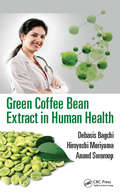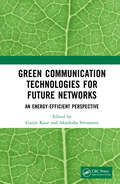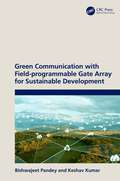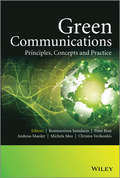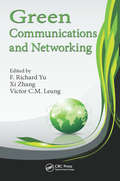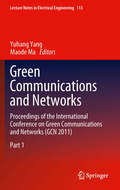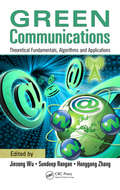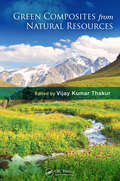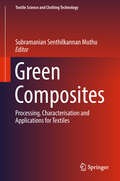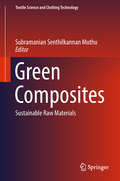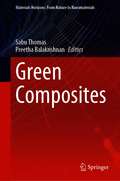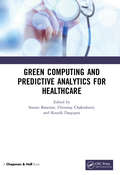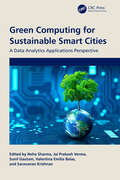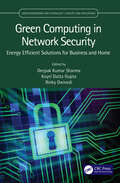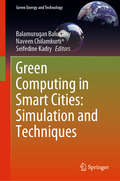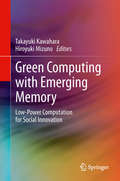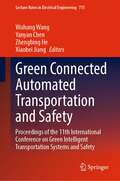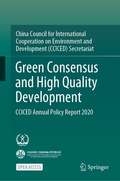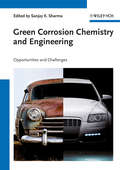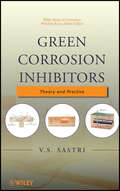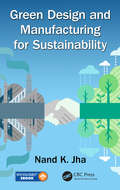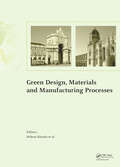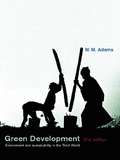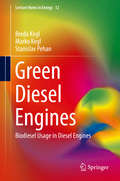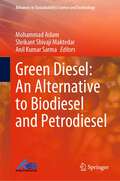- Table View
- List View
Green Coffee Bean Extract in Human Health
by Debasis Bagchi Hiroyoshi Moriyama Anand SwaroopThe role of green coffee bean (GCB) in human health is of emerging interest to the nutraceutical field, especially given its role in improving metabolic syndrome, including weight management, hypertension, diabetes, and neuroprotection. GCB extract contains a novel antioxidant known as chlorogenic acid (also caffeoylquinic acid), which has been shown to positively affect blood pressure, brain health, diabetes, and weight management. This book provides information on the diverse health benefits of green coffee bean extract, molecular mechanisms and signaling pathways, safety of GCB, dosage, and recommended usage. It focuses on the chemistry, biochemistry, pharmacology, and safety of GCB extract. GCB extract has brought a remarkable revolution in the nutraceutical marketplace. However, some controversies have been demonstrated recently. This book presents the state-of-the-art research studies from eminent scientists around the world on the potential and diversified health benefits of GCB extracts, with particular emphasis placed on the importance to standardize the appropriate extraction technology, quality control and assurance, and broad spectrum safety studies and human clinical studies to substantiate the regulatory claims and position the product in the marketplace.
Green Communication Technologies for Future Networks: An Energy-Efficient Perspective
by Gurjit Kaur Akanksha SrivastavaThis book explores all the energy-efficient communication technologies used for various communication systems and every aspect of these systems, such as green electronics, network protocols, handover, codes, antenna, and the role of artificial intelligence and IoT, including the energy management strategies. It identifies the development of sustainable plans and programs at the communication level within the current legislative framework. Features: Gives a fundamental description of the green communications including granularities of green wired and wireless systems. Describes a comprehensive review of innovations, challenges, and opportunities for green communication. Provides guiding principles on how to build the green communication network. Includes a holistic view of both wireless and wired green communication systems with an emphasis on applications and challenges in each area. Suggests various ways of benchmarking and measuring the performance of green communication systems. This book will be of great interest to graduate students and researchers in green technologies, communications, wireless communication, optical communication, underwater communication, microwave and satellite communication, networking, the internet of things, and energy management.
Green Communication with Field-programmable Gate Array for Sustainable Development
by Bishwajeet Pandey Keshav KumarThe text discusses the designing of field-programmable gate array based green computing circuits for efficient green communication. It will help senior undergraduate, graduate students, and academic researchers from diverse engineering domains such as electrical, electronics and communication, and computer. Discuss hardware description language coding of green communication computing (GCC) circuits. Presents field-programmable gate arrays-based power-efficient models. Explored the integrations of universal asynchronous receiver/transmitter and field-programmable gate arrays. Covers architecture, and programming tools of field-programmable gate arrays. Showcases Verilog and VHDL codes for green computing circuits such as finite impulse response filter, parity checker, and packet counter. The text discusses the designing of energy-efficient network components, using low voltage complementary metal-oxide semiconductors, high-speed transceiver logic, and stub series-terminated logic input/output standards. It showcases how to write Verilog and VHDL codes for green computing circuits including finite impulse response filter, packet counter, and universal asynchronous receiver-transmitter. It will serve as an ideal reference text for senior undergraduate, graduate students, and academic researchers in the fields including electrical engineering, electronics and communication engineering, and computer engineering.
Green Communications
by Peter Rost Andreas Maeder Christos Verikoukis Konstantinos Samdanis Michela MeoThis book provides a comprehensive view of green communications considering all areas of ICT including wireless and wired networks. It analyses particular concepts and practices, addressing holistic approaches in future networks considering a system perspective. It makes full use of tables, illustrations, performance graphs, case studies and examples making it accessible for a wide audience.e overviewed and categorized before particular examples demonstrate their applicability on specific segments of a telecommunication network. The book aims to elaborate specific mechanisms considering wired or fixed and wireless communication networks as well as all network layers of a telecommunication network emphasizing a system perspective. The objective is to create a holistic approach, which combines different wired and wireless mechanisms towards a comprehensive solution for green communications. This book provides a comprehensive view of green communications considering all areas of ICT including wireless and wired networks. It analyses particular concepts and practices, addressing holistic approaches in future networks considering a system perspective. It makes full use of tables, illustrations, performance graphs, case studies and examples making it accessible for a wide audience.
Green Communications and Networking
by F. Richard Yu Victor C. M. Leung Xi ZhangGreen Communications and Networking introduces novel solutions that can bring about significant reductions in energy consumption in the information and communication technology (ICT) industry-as well as other industries, including electric power. Containing the contributions of leading experts in the field, it examines the latest research advances
Green Communications and Networks
by Chenguang Yang Maode MaThe objective of GCN 2011 is to facilitate an exchange of information on best practices for the latest research advances in the area of green communications and networks, which mainly includes the intelligent control, or efficient management, or optimal design of access network infrastructures, home networks, terminal equipment, and etc. Topics of interests include network design methodology, enabling technologies, network components and devices, applications, others and emerging new topics.
Green Communications: Theoretical Fundamentals, Algorithms, and Applications
by Honggang Zhang Jinsong Wu Sundeep RanganNowadays energy crisis and global warming problems are hanging over everyone's head, urging much research work on energy saving. In the ICT industry, which is becoming a major consumer of global energy triggered by the telecommunication network operators experiencing energy cost as a significant factor in profit calculations, researchers have start
Green Composites from Natural Resources
by Vijay Kumar ThakurGlobal awareness of environmental issues has resulted in the emergence of economically and environmentally friendly bio-based materials free from the traditional side effects of synthetics. This book delivers an overview of the advancements made in the development of biorenewable resources-based materials, including processing methods and potential applications in bio-based green composites. Covering various kinds of cellulosic biofibers, the text provides information on more eco-friendly and sustainable alternatives to synthetic polymers and discusses the present state and growing utility of green materials from natural resources.
Green Composites: Processing, Characterisation And Applications For Textiles (Textile Science And Clothing Technology Ser.)
by Subramanian Senthilkannan MuthuThis book highlights the processing, characterization and applications of various green composites. Composites are known for their unique properties, which are derived by combining two or more components. This yields properties such as greater strength and rigidity than that of the individual components, as well as reduced weight. To help achieve such outcomes, the book discusses the potential applications of hybrid bio-composites and sisal-fiber-reinforced epoxidized non-edible oil-based epoxy green composites.
Green Composites: Sustainable Raw Materials (Textile Science and Clothing Technology)
by Subramanian Senthilkannan MuthuThis book highlights the production of green composites from various sustainable raw materials. We now live in an environmentally conscious era, in which sustainable raw materials (renewable, biodegradable, recycled), sustainable processing sequences, the production of recyclable and biodegradable products, and avoiding the depletion of renewable resources are key considerations with regarding to producing any product. The textile sector is no exception. Accordingly, this book addresses these aspects in connection with textiles, and discusses how they can be actively practiced.
Green Composites: Volume 1: Composites (Materials Horizons: From Nature to Nanomaterials #Volume 16)
by Sabu Thomas Preetha BalakrishnanThis book presents important developments in green chemistry, with a particular focus on composite materials chemistry. In recent years, natural polymers have generated much interest due to their unique morphology and physical properties. The book gives an introductory overview of green composites, and discusses their emerging interdisciplinary applications in various contemporary fields. The chapters, written by leading experts from industry and academia, cover different aspects of biodegradable green composites and natural polymers including their processing, manufacturing, properties, and applications. This book will be a valuable reference for beginners, researchers as well as industry professionals interested in biodegradable composites.
Green Computing and Predictive Analytics for Healthcare
by Sourav Banerjee, Chinmay Chakraborty and Kousik DasguptaGreen Computing and Predictive Analytics for Healthcare excavates the rudimentary concepts of Green Computing, Big Data and the Internet of Things along with the latest research development in the domain of healthcare. It also covers various applications and case studies in the field of computer science with state-of-the-art tools and technologies. The rapid growth of the population is a challenging issue in maintaining and monitoring various experiences of quality of service in healthcare. The coherent usage of these limited resources in connection with optimum energy consumption has been becoming more important. The major healthcare nodes are gradually becoming Internet of Things-enabled, and sensors, work data and the involvement of networking are creating smart campuses and smart houses. The book includes chapters on the Internet of Things and Big Data technologies. Features: Biomedical data monitoring under the Internet of Things Environment data sensing and analyzing Big data analytics and clustering Machine learning techniques for sudden cardiac death prediction Robust brain tissue segmentation Energy-efficient and green Internet of Things for healthcare applications Blockchain technology for the healthcare Internet of Things Advanced healthcare for domestic medical tourism system Edge computing for data analytics This book on Green Computing and Predictive Analytics for Healthcare aims to promote and facilitate the exchange of research knowledge and findings across different disciplines on the design and investigation of healthcare data analytics. It can also be used as a textbook for a master’s course in biomedical engineering. This book will also present new methods for medical data evaluation and the diagnosis of different diseases to improve quality-of-life in general and for better integration of Internet of Things into society. Dr. Sourav Banerjee is an Assistant Professor at the Department of Computer Science and Engineering of Kalyani Government Engineering College, Kalyani, West Bengal, India. His research interests include Big Data, Cloud Computing, Distributed Computing and Mobile Communications. Dr. Chinmay Chakraborty is an Assistant Professor at the Department of Electronics and Communication Engineering, Birla Institute of Technology, Mesra, India. His main research interests include the Internet of Medical Things, WBAN, Wireless Networks, Telemedicine, m-Health/e-Health and Medical Imaging. Dr. Kousik Dasgupta is an Assistant Professor at the Department of Computer Science and Engineering, Kalyani Government Engineering College, India. His research interests include Computer Vision, AI/ML, Cloud Computing, Big Data and Security.
Green Computing for Sustainable Smart Cities: A Data Analytics Applications Perspective
by Valentina Emilia Balas Neha Sharma Saravanan Krishnan Jai Prakash Verma Sunil GautamInformation and communication technology and the Internet of Things play key roles in smart city projects. It is challenging to handle the large amount of data generated by the different processes related to land use, the environment, the social and economic milieu, energy consumption, and transportation. This book emphasizes that green computing-based infrastructure initiatives benefit not only the environment but the enterprise as well.Green Computing for Sustainable Smart Cities: A Data Analytics Applications Perspective covers the need for smart green computing from various engineering disciplines and offers diversified applications for such computing with cases studies. The book highlights the sustainable development of smart cities using recent technology and emphasizes advances and cutting-edge techniques throughout. Focused on the different tools, platforms, and techniques associated with smart green computing, this book presents multiple perspectives from academia, industry, and research fields.The primary audience for this book includes academics, researchers, graduate students, smart city industry practitioners, and city administrators who are engaged in smart cities and related technology.
Green Computing in Network Security: Energy Efficient Solutions for Business and Home (Green Engineering and Technology)
by Deepak Kumar SharmaThis book focuses on green computing-based network security techniques and addresses the challenges involved in practical implementation. It also explores the idea of energy-efficient computing for network and data security and covers the security threats involved in social networks, data centers, IoT, and biomedical applications. Green Computing in Network Security: Energy Efficient Solutions for Business and Home includes analysis of green-security mechanisms and explores the role of green computing for secured modern internet applications. It discusses green computing-based distributed learning approaches for security and emphasizes the development of green computing-based security systems for IoT devices. Written with researchers, academic libraries, and professionals in mind so they can get up to speed on network security, the challenges, and implementation processes.
Green Computing in Smart Cities: Simulation and Techniques (Green Energy and Technology)
by Naveen Chilamkurti Seifedine Kadry Balamurugan BalusamyThe book collects the latest research and thinking from international experts on green computing and the smart city. The financial and environmental costs of energy are a concern in smart cities due to the high usage of computing, technology, security, IoT, communications, traffic, and other technologies. This book tackles this problem with a focus on computing, reporting on various approaches being taken worldwide, illustrated by several international case studies demonstrating these approaches. Researchers use this book as an up-to-date reference and engineers use it as a guide for the design and implementation of real solutions.
Green Computing with Emerging Memory
by Takayuki Kawahara Hiroyuki MizunoThis book describes computing innovation, using non-volatile memory for a sustainable world. It appeals to both computing engineers and device engineers by describing a new means of lower power computing innovation, without sacrificing performance over conventional low-voltage operation. Readers will be introduced to methods of design and implementation for non-volatile memory which allow computing equipment to be turned off normally when not in use and to be turned on instantly to operate with full performance when needed.
Green Connected Automated Transportation and Safety: Proceedings of the 11th International Conference on Green Intelligent Transportation Systems and Safety (Lecture Notes in Electrical Engineering #775)
by Wuhong Wang Xiaobei Jiang Yanyan Chen Zhengbing HeThese proceedings gather selected papers from the 11th International Conference on Green Intelligent Transportation Systems and Safety, held in Beijing, China on October 17-19, 2020. The book features cutting-edge studies on Green Intelligent Mobility Systems, the guiding motto being to achieve “green, intelligent, and safe transportation systems”. The contributions presented here can help promote the development of green mobility and intelligent transportation technologies to improve interconnectivity, resource sharing, flexibility and efficiency. Given its scope, the book will benefit researchers and engineers in the fields of Transportation Technology and Traffic Engineering, Automotive and Mechanical Engineering, Industrial and System Engineering, and Electrical Engineering alike. The readers will be able to find out the Advances in Green Intelligent Transportation System and Safety.
Green Consensus and High Quality Development: CCICED Annual Policy Report 2020
by CCICEDThis open access book is based on the research outputs of China Council for International Cooperation on Environment and Development (CCICED) in 2020. It covers major topics of Chinese and international attention regarding green development, such as climate, biodiversity, ocean, BRI, urbanization, sustainable production and consumption, technology, finance, value chain, and so on. It also looks at the progress of China’s environmental and development policies,and the impacts from CCICED. This is a highly informative and carefully presented book, providing insight for policy makers in environmental issues.
Green Corrosion Chemistry and Engineering: Opportunities and Challenges
by Sanjay K. SharmaWith its unique focus on specifically addressing the problems for societies and economies associated with corrosion and their solution, this book provides an up-to-date overview of the progress in corrosion chemistry and engineering. International experts actively involved in research and development place particular emphasis on how to counter the economic and environmental consequences of corrosion with the help of science and technology, making this a valuable resource for researchers as well as decision makers in industry and politics. Further major parts of the book are devoted to corrosion prevention in the naval and energy sector as well as to corrosion monitoring and waste management.
Green Corrosion Inhibitors
by V. S. SastriA book to cover developments in corrosion inhibitors is long overdue. This has been addressed by Dr Sastri in a book which presents fundamental aspects of corrosion inhibition, historical developments and the industrial applications of inhibitors. The book deals with the electrochemical principles and chemical aspects of corrosion inhibition, such as stability of metal complexes, the Hammett equation, hard and soft acid and base principle, quantum chemical aspects and Hansch' s model and also with the various surface analysis techniques, e. g. XPS, Auger, SIMS and Raman spectroscopy, that are used in industry for corrosion inhibition. The applications of corrosion inhibition are wide ranging. Examples given in this book include: oil and gas wells, petrochemical plants, steel reinforced cement, water cooling systems, and many more. The final chapters discuss economic and environmental considerations which are now of prime importance. The book is written for researchers in academia and industry, practicing corrosion engineers and students of materials science, engineering and applied chemistry.
Green Design and Manufacturing for Sustainability
by Nand K. JhaThis textbook integrates green design and manufacturing within the framework of sustainability, emphasizing cost, recyclables, and reuse. This book includes the analytical techniques for cost minimization, reduction of material waste, and the reduction of energy consumption during the manufacturing process. All aspects of green design, economics, feasible material selection, and relevant and efficient manufacturing processes are presented. Techniques including life cycle cost assessment, reuse, and recyclables are showcased with examples and problems solved.
Green Design, Materials and Manufacturing Processes
by José Pinto Duarte Filipa Roseta Helena Maria Bártolo Henrique Amorim Almeida Flávio Craveiro Paulo Jorge da Silva Bártolo Nuno Manuel Fernandes Alves Artur Jorge Mateus Ana Cristina Soares Lemos Carina Ramos Igor Reis Lina Durão Telma Ferreira Eduardo Castro e Costa Filipe Quaresma João Paulouro NevesGreen Design, Materials and Manufacturing Processes includes essential research in the field of sustainable intelligent manufacturing and related topics, containing reviewed papers presented at the 2nd International Conference on Sustainable Intelligent Manufacturing 2013. Topics covered include Eco Design and Innovation, Energy Efficiency, Green and Smart Manufacturing, Green Transportation, Life-Cycle Engineering, Renewable Energy Technologies, Reuse and Recycling Techniques, Smart Design, Smart Materials, Sustainable Business Models and Sustainable Construction. Intended for engineers, architects, designers, economists and manufacturers dealing with key sustainability issues.
Green Development: Environment and Sustainability in the Third World
by W. M. AdamsThis revised and updated new edition retains the clear and powerful argument which characterized the original. It gives a valuable analysis of the theory and practice of sustainable development and suggests that at the start of the new millennium, we should think radically about the challenge of sustainability. Fully revised, this latest edition includes further reading, chapter outlines, chapter summaries and new discussion topics, and explores: the roots of sustainable development thinking and its evolution in the last three decades of the twentieth century the dominant ideas within mainstream sustainable development the nature and diversity of alternative ideas about sustainability the problems of environmental degradation and the environmental impacts of development strategies for building sustainability in development from above and below. Offering a synthesis of theoretical ideas on sustainability based on the industrialized economies of the North and the practical, applied ideas in the South which tend to ignore 'First World' theory, this important text gives a clear discussion of theory and extensive practical insights drawn from Africa, Latin America and Asia.
Green Diesel Engines
by Breda Kegl Marko Kegl Stanislav PehanWith a focus on ecology, economy and engine performance, diesel engines are explored in relation to current research and developments. The prevalent trends in this development are outlined with particular focus on the most frequently used alternative fuels in diesel engines; the properties of various type of biodiesel and the concurrent improvement of diesel engine characteristics using numeric optimization alongside current investigation and research work in the field. Following of a short overview of engine control, aftertreatment and alternative fuels, Green Diesel Engine explores the effects of biodiesel usage on injection, fuel spray, combustion, and tribology characteristics, and engine performance. Additionally, optimization procedures of diesel engine characteristics are discussed using practical examples and each topic is corroborated and supported by current research and detailed illustrations. This thorough discussion provides a solid foundation in the current research but also a starting point for fresh ideas for engineers involved in developing/adjusting diesel engines for usage of alternative fuels, researchers in renewable energy, as well as to engineers, advanced undergraduates, and postgraduates.
Green Diesel: An Alternative to Biodiesel and Petrodiesel (Advances in Sustainability Science and Technology)
by Mohammad Aslam Shrikant Shivaji Maktedar Anil Kumar SarmaThis book covers the entire spectrum of green diesel and their applications in existing CI engines. This book discusses how a green diesel is a better fuel than biodiesel and petrodiesel and more suitable fuels for sustainable future development. The book begins with a concise overview of the fundamentals of the green diesel properties, preparation, and characterization of green diesel using hydroprocessing technology. The book covers recent developments in the domain of green diesel derived particularly from the second-/third-generation feedstocks. Various topics covered in this book include the catalysts involved in the processing of green diesel, characterization of the products as per ASTM/EN protocols. In addition, the book also illustrates characteristic features of green diesel and how it is different from biodiesel and petrodiesel. Other chapters cover performance and emission characteristics of green diesel in CI engines and techno-economic analysis. Moreover, the current status of green diesel industries is also incorporated. This book is of particular interest to graduate students and academic or industrial researchers/professionals working in the area of green diesel/green energy, bioenergy and mechanical, automobile, and chemical engineering. This book makes a forceful foundation for the establishment of green diesel refineries/biorefineries for a sustainable, cleaner, and greener future.
